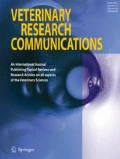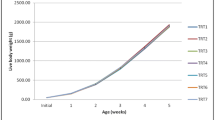Abstract
The term growth promotion applies to the increase in performance or productivity achieved in food producing animals following the addition to their diet of feed antibiotics or growth promoters. Numerous methods are available for the different animal species. Steroidal substances are widely used in cattle whilst in pigs and poultry a wide range of substances are used to influence the gastro-intestinal microflora and thereby bring about a cost-effective improvement in productivity. Although certain antibiotics have been used for growth promotion for over three decades they are still highly effective and appear not to have reduced the value of other widely used antibiotics for the treatment of disease. The mechanisms by which growth promotion is produced are only poorly understood but it is now generally accepted that any improvement in performance is directly related to a variety of direct effects on the gut microbial flora and associated indirect effects on intestinal tissues. The direct effects include inhibition of bacterial growth, interference with bacterial cell wall development, induction of filament formation and interference with the metabolism of intestinal bacteria. The indirect effects include a reduction in the thickness of the intestinal mucosal layer and a decrease in the production of certain mucosal cell enzymes. Other effects seen in the gut of growth promoted animals and birds include a decrease in the prevalence of antibiotic resistance plasmids and a reduced frequency of plasmid transfer in enteric coliforms. It is clear from available data that conventional animals are depressed in performance and this depression can be alleviated by the administration of growth promoting agents in the diet of these animals. The lifting of this depression results in an improvement in performance especially daily live weight gain and feed conversion efficiency.
Similar content being viewed by others
References
Gale, E.F., 1946. The bacterial amino acid decarboxylases. Adv. in Enzymol., 6: 1–32.
Garrod, L.P., Lambert, H.P. and O'Grady, F., 1973. Antibiotic and Chemotherapy. Churchill-Livingstone, London.
Gomori, G., 1939. Microtechnical demonstration of phosphatase in tissue sections. Proc. Soc. exp. Biol. Med., 42: 23–26.
Larson, N. and Hill, E.G., 1960. Amine formation and metabolic activity of micro organisms in the ileum of young swine fed chlortetracycline. J. Bact., 80: 188–192.
Malamy, M. and Horecker, B.L., 1961. The localization of alkaline phosphatase inE. coli K12. Biochem. Biophys. Res. Commun., 5: 104–108.
Michel, M. and Francois, A.C., 1956. Influence de la chlortetracycline sur les decarboxylases de la flore intestinale du porc. Compt. Rend., 242: 1770–1772.
Moog, F. and Glazier, H.S., 1972. Phosphate absorption and alkaline phosphatase activity in the small intestine of the adult mouse and chick embryo and hatched chick. Comp. Biochem. Physiol., 424: 321–336.
Oda, T.S., Seki, S. and Watanabe, S., 1969. Molecular basis of structure and function of the microvillus membrane of intestinal epithelial cells. Aca. Med. Okayama., 23: 357–376.
Ripley, P.H. and Brown, D.J., 1978. The effect of an antibacterial growth promoter on the levels of alkaline phosphatase. Proc. Nut. Soc., 38: 10A.
Walton, J.R. and Bird, R.G., 1975. A possible mechanism to explain the growth promotion effect of feed antibiotics in farm animals: Zinc bacitracin induced cell wall damage inEscherichia coli in vitro. Zbl. Vet. Med. B. 22: 318–325.
Walton, J.R. and King, J.O.L., 1980. Concentration of intestinal alkaline phosphatase activity in the broiler chicken. (Unpublished results).
Walton, J.R. and Laerdal, O.A., 1980. The effect of zinc bacitracin in the feed on the resistance status of porcine strains ofEscherichia coli. Proc. Inter. Pig Vet. Soc. Copenhagen., P. 300.
Wilson, T.H. and Wilson, D.W., 1958. Studies in vitro of digestion and absorption of pyramidine nucleotides by the intestine. J. Biol. Chem., 233: 1544–1547.
Yolton, D.P., Stanley, C. and Savage, D.C., 1971. Influence of the indigenous gastrointestinal microbial flora on duodenal alkaline phosphatase activity in mice. Infection and Immunity, 3: 768–773.
Author information
Authors and Affiliations
Rights and permissions
About this article
Cite this article
Walton, J.R. Modes of action of growth promoting agents. Vet Res Commun 7, 1–7 (1983). https://doi.org/10.1007/BF02228589
Issue Date:
DOI: https://doi.org/10.1007/BF02228589




